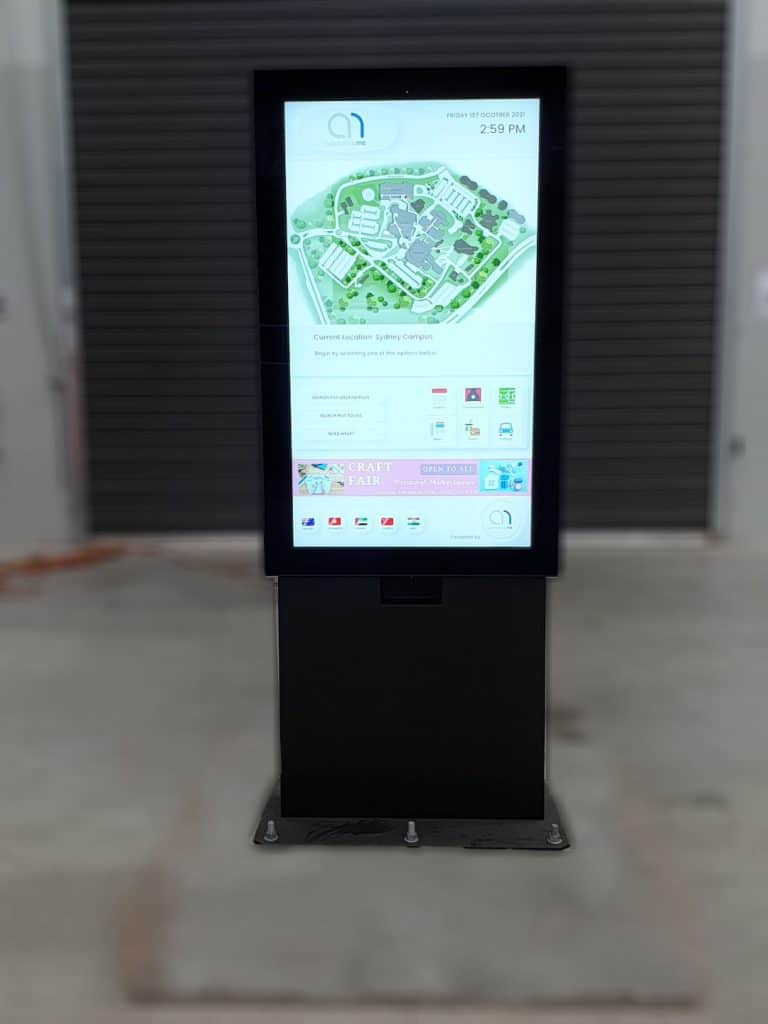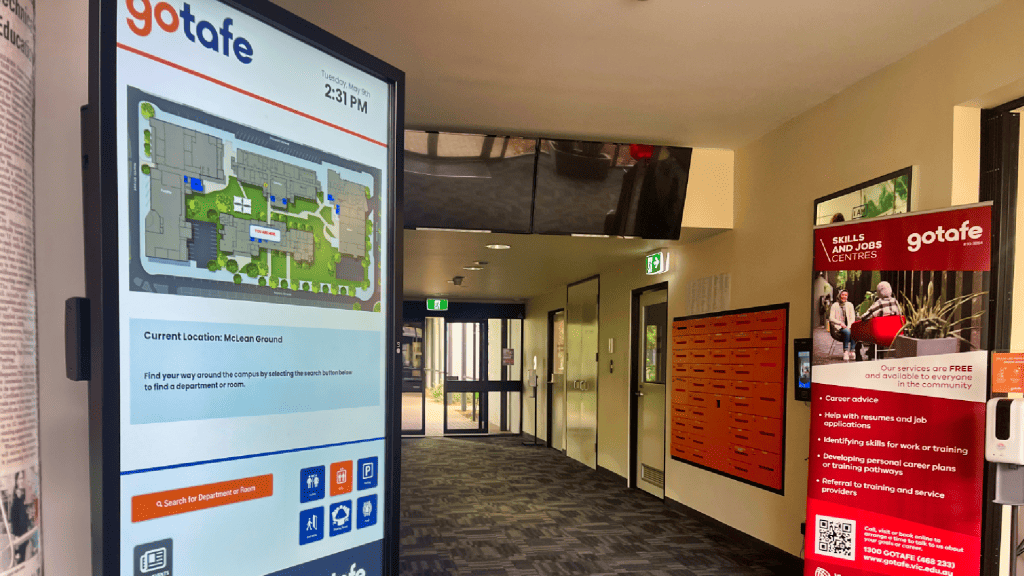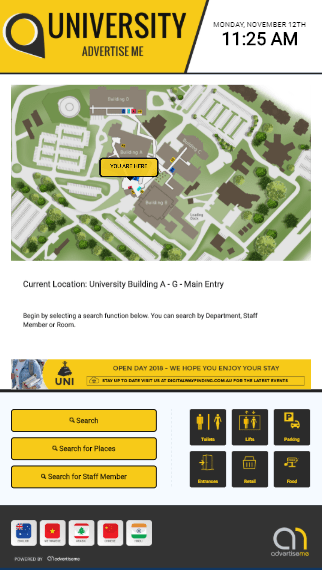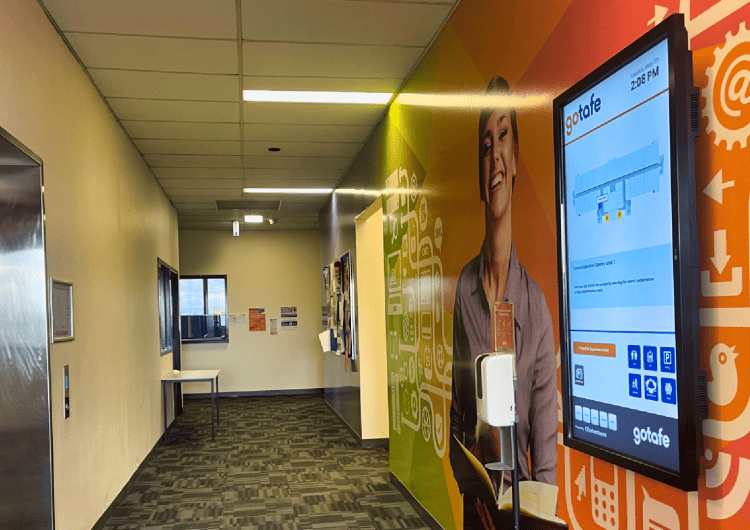The use of digital wayfinding is changing the way TAFE students navigate their campuses. With the help of interactive kiosks and digital maps, students can easily locate their classrooms, lecture halls, and other important areas of the campus. This technology enables students to find their destination both indoors and outdoors, saving them time and resources. By utilising digital tools to efficiently navigate college environments, TAFE scholars can make the most of their valuable time.

Understanding the Concept of Digital Wayfinding
The use of digital wayfinding is gaining popularity in TAFE education. It involves utilising digital technology to simplify students’ access and interaction with their learning environment. This can be achieved through the use of interactive maps, displaying news and events, and even displaying QR codes so students can take the maps with them. With the help of digital wayfinding, students can easily locate their classrooms, find resources quickly, and stay updated on important information about their courses. Higher education institutions can make use of digital wayfinding in various ways.
Digital wayfinding is an innovative solution that enables users to effortlessly access important information from external systems. This includes the latest updates on website news as well as upcoming TAFE events. With this powerful tool at their fingertips, users can stay informed and up-to-date on all the latest happenings in their community.
Moreover, educational establishments can also take advantage of digital wayfinding in order to create virtual tours of their campus buildings and other facilities. This will provide potential new students with an idea of what the grounds look like prior to them setting foot on it, therefore allowing them more time during orientation day itself for exploration rather than desperately trying to become acquainted with a layout they have never seen before.
Digital Wayfinding is also beneficial for disabled individuals requiring special accommodations when navigating unfamiliar environments such as those found at universities campuses, providing them with detailed directions regarding how best to access certain resources including elevators and ramps; thus ensuring that all staff members are held accountable in keeping these pathways accessible at all times.
The integration of digital wayfinding in TAFE education offers many benefits that are appealing to both educators and learners. These advantages include improved navigation around campus both indoors and outdoors by using interactive kiosks, simple directions for prospective students, and assistance for disabled individuals travelling through unfamiliar areas. Overall, digital wayfinding makes the educational experience at TAFE more convenient and efficient.

The Role of Digital Wayfinding in TAFE Education
The use of digital wayfinding technology has become increasingly important in TAFE education. It provides a simple and effective system for colleges to guide students and visitors around campuses, making it easier for them to reach their desired destinations quickly and without any hassle.
A digital wayfinding system can be very helpful for students navigating through their courses. These systems offer interactive maps that allow students to easily find their classrooms, libraries, study spaces, and other important areas on campus. They can also help students locate amenities like cafeterias and restrooms. With these maps, students can find their way through their courses more efficiently and without having to constantly ask faculty for directions.
Digital wayfinding kiosks placed at main entrances can replace the need for reception staff to work after hours at TAFE. This strategic placement allows for a more efficient and cost-effective solution.
Advantages of Using Digital Maps for TAFE Campuses
TAFE campuses are starting to adopt digital maps for navigation purposes. Digital maps offer a more convenient and efficient way of moving around campus compared to traditional paper-based or hand-drawn charts. They provide a more accurate representation of the layout of the grounds, allowing students to easily find their way around. Moreover, digital maps are more interactive than their traditional counterparts, enabling students to click on points of interest and obtain directions from one location to another.
Digital wayfinding for TAFE campuses offers a significant advantage with its easy adaptability to changes in buildings or routes over time. This ensures that students have access to the most current information about their surroundings, leading to faster and more precise arrival at their destination. Moreover, these systems can be integrated with other applications, such as class schedules and student check-ins, eliminating the need for students to sift through piles of paperwork each semester to locate their classrooms.
With our Wayfinding Content Management System, integrating and displaying directional wayfinding at crucial intersections or areas where students often get lost becomes effortless. You can manage smart directional boards, digital wayfinding kiosks, and more on a single platform.
At TAFE campuses, interactive digital displays provide visitors and new enrollees with an instant overview of the available services on site, as well as relevant contact details to access help if needed during their stay.
Boosting Student Navigation with Map Locations
Clear instructions on signage and digital displays in key areas of the campus can help students navigate with ease. A digital wayfinding solution, such as QR codes, can further enhance student engagement with TAFE institutions. This allows users to access information about buildings and courses directly from their smartphones beyond what is visible on the physical map.
By utilising digital mapping systems and existing analytics platforms, students can make more informed decisions when navigating their campus. This includes determining which classes to attend and finding appropriate gathering places for fellow classmates, ultimately leading to increased involvement with instructors and peers. Additionally, TAFE facilities management teams can use these technologies to monitor occupancy levels and observe behavioural patterns across multiple locations over time. This allows them to gain essential insights into how to improve the student navigation experience on-site. By analysing data collected from these systems, personnel can identify areas where enhancements could be made, such as augmenting current signage or creating new paths between prominent destinations. This ultimately results in a superior user experience overall and helps to alleviate overcrowding in specific areas across the college if necessary.
Improving Access to Facilities through Digital Signage
Assisting the entry of students and staff in TAFE education facilities is becoming increasingly important, and digital signage plays a crucial role in this regard. By using digital wayfinding, up-to-date information regarding available spaces, room numbers, and other useful details can be provided to users. This enables them to quickly find what they need with minimal effort. Additionally, digital signage can guide individuals around campus or buildings while also alerting them to potential hazards like closed-off staircases or restricted areas.
Digital wayfinding has become increasingly popular in educational institutions, as it allows users to easily locate their desired destinations. This technology displays a map of the area on a monitor, highlighting points of interest such as classrooms and laboratories. Users can then hover over these points to access additional information, such as availability times or directions to other areas within the campus.
In addition, digital signage provides users with access to additional content related to their destination. This can include pictures of significant places or videos that showcase what each venue has to offer. Additionally, digital signage solutions have become more user-friendly and are suitable for individuals who may not have extensive experience with technology-driven systems.
Digital wayfinding solutions in TAFE education offer numerous benefits, such as improved access through optimised navigation and enhanced safety measures when exploring unfamiliar campuses. As this technology gains more recognition among educational institutions, it is clear that it will continue to play a vital role in helping individuals reach their destinations quickly and easily.

Case Studies: Successful Implementation of Digital Wayfinding in TAFE Institutions
Studies have shown that implementing digital wayfinding systems on campus can significantly decrease the time it takes for students and faculty to navigate their way around. This, in turn, can enhance student engagement and satisfaction. These systems are particularly useful in reducing confusion by offering clear directions that guide users towards their desired destination. Moreover, they provide access to real-time information on-campus events and schedules at any given location.
Institutions of higher education, particularly TAFE and universities, recognise the growing significance of digital wayfinding. As online learning and distance education continue to gain popularity, campuses face the challenge of providing students with precise and prompt information. Case studies can be useful in understanding how digital wayfinding can benefit both learners and educators. By examining successful implementations of this technology in TAFE institutions, we can gain valuable insights. You can read about the GOTAFE digital wayfinding solution.

Digital wayfinding offers many benefits for facility managers. Studies have shown that it reduces the time it takes for visitors to navigate the facility, leading to increased enthusiasm from attendees and higher levels of satisfaction among staff. Advanced systems have been developed that provide clear guidance to travelers, directing them to their destinations while also providing up-to-date information about events and schedules throughout the university campus. This makes navigation much more efficient overall.
Providing users with a simple system for navigating college campuses can help reduce confusion. By offering detailed maps that include key locations such as classrooms, lecture halls, cafeterias, libraries, and more, students can quickly find their way without wasting time asking for directions. Digital wayfinding systems also often provide helpful information about the institution’s services, from academic resources to outdoor activities available on campus. These resources are easily accessible through an interactive mapping interface or mobile app.
In addition, digital wayfinding solutions offer TAFE institutions the opportunity to increase their visibility and promote their brand identity with unique designs that reflect the individual character of each campus layout. By incorporating symbols and other visual elements into these systems, they create memorable experiences that attract potential visitors beyond current students – ultimately converting them into advocates who encounter them on a daily basis. Additionally, electronic signage solutions provide an effective platform for quickly conveying urgent messages, such as weather-related closures or unexpected facility maintenance issues. This is especially important on large campuses where traditional methods like posters or flyers may not reach everyone in a timely manner due to distance or lack of exposure in certain areas of the premises. Therefore, having a reliable digital wayfinding solution can make all the difference in keeping everyone informed during critical situations like these.
Challenges and Solutions in Implementing Digital Wayfinding for TAFE Education
Utilising digital wayfinding can greatly enhance the experience of TAFE education providers for their students. This tool enables students to efficiently navigate the campus and take advantage of available resources and facilities. However, its implementation can pose challenges as it relies on technology.
The main concern in this situation is the cost. Implementing digital wayfinding solutions requires investing in both hardware and software, which can be too expensive for institutes under the TAFEs umbrella that operate with limited budgets.

In addition, some retailers may lack the necessary equipment or software to implement digital wayfinding solutions, requiring the assistance of a dedicated supplier. Additionally, staff training is necessary prior to implementing the system on campus to ensure effective use. Introducing digital wayfinding systems at TAFEs across Australia may be a trade-off between investing time and effort into the system versus other tasks related to student learning experiences and well-being initiatives. It is also important to consider data privacy concerns when introducing new technology-based solutions such as digital wayfinding in educational settings.
Future Trends in Digital Wayfinding for Educational Settings
The topic of digital wayfinding has become a popular discussion in educational settings. Thanks to advancements in technology, digital wayfinding software can now assist students and staff in navigating their campuses more efficiently. These programs offer routes for campus buildings and provide information about specific locations such as classrooms, offices, and other services.
In today’s technologically advanced world, traditional paper-based maps used by universities are becoming less relevant. As a result, educational institutions are turning to digital mapping solutions that offer a comprehensive understanding of their grounds without the need for physical charts or signage. These electronic services also provide users with quick and easy access to their desired destinations, including detailed instructions and immediate access to additional information about points of interest such as libraries or eateries.
Digital wayfinding applications not only provide directions for navigating campus but also offer additional features such as real-time updates on university events. This is particularly helpful for students who attend classes at different times or those who are exploring new areas outside of the classroom environment. It ensures that they are aware of any events happening during their stay at the university.
It’s evident that digital wayfinding solutions offer numerous benefits compared to traditional paper-based methods when navigating educational settings, like TAFE institutions. Some apps even have augmented reality (AR) capabilities, allowing users to take a virtual tour of specific areas on campus. AR apps display virtual signs on physical buildings, so users don’t have to rely on printed maps or signage when exploring unfamiliar areas. Additionally, using modern technologies provides real-time updates to users’ devices, enabling them to stay informed about campus events and find their desired destination quickly and efficiently with detailed instructions from AR-enabled apps. Overall, these solutions make navigating campus easier for everyone involved.
How to Maximise the Benefits of Using Digital Wayfinding at TAFEs
TAFE students can now enjoy the convenience of digital wayfinding, which allows them to easily and quickly navigate their campuses. This technology not only saves time and effort, but also maximises the benefits of their studies. With the help of digital tools, learners can effortlessly locate classrooms, libraries, laboratories, and other facilities. Additionally, this method of wayfinding reduces costs associated with campus mapping, eliminating the need for signage or printed materials.
There are numerous benefits to implementing digital wayfinding systems at TAFEs. However, it is important to consider some key advantages when deciding if this system is appropriate for your institution. One of the primary benefits is the ease of navigation on large campuses. With an easy-to-use system in place, students can move from one location to another without any confusion or wasted time trying to figure out where to go next.
Another advantage of digital wayfinding is that it provides a cost-effective solution, eliminating the need for expensive signage and printed materials that are typically required to help people find their destination. Moreover, with its interactive capabilities, digital wayfinding has the potential to engage users in a more meaningful experience than traditional navigation methods like paper maps or printed directions, which often lack information about what is available at each location on campus.
Organisations can easily find solutions that meet their requirements and provide a positive user experience by contacting us. We will help unlock the full potential of implementing digital technologies in higher education environments and reap all possible benefits.
Are you looking for a customised digital wayfinding solution to meet your business needs? Look no further than Digital Wayfinding Solutions. Our team of experienced professionals have the expertise to help you achieve your wayfinding goals. Let us show you how Digital Wayfinding Solutions can elevate your business to the next level.

